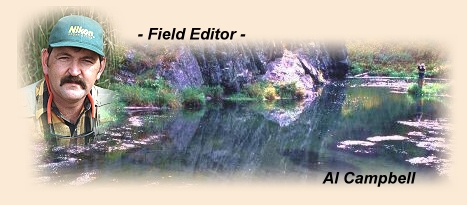|
What type of head cement do you use?
I use several types of head cement because each type of head
cement has its own characteristics and thus value to the fly
tying enthusiast.
The one I use the most I make myself. It's a blend of Cabelas
clear Gloss Coat jig head paint (the label calls it "one part epoxy").
I add acetone until I achieve the right constancy to penetrate
deep into the thread wraps. This stuff is strong enough to seal
cracks in Plexiglas, but is flexible enough to coat feathers for
wing cases on nymphs. Since it's a solvent-based cement be mindful
of having good ventilation.
Another solvent-based head cement I make myself is a cellulose
dope mix. In case you don't know what cellulose dope is, here's
a brief explanation. Cellulose dope is the stuff model airplane
builders smear on the canvas and/or paper skins of their model
airplanes to make them hard and sturdy. Good stuff; dries clear,
hard and flexible. You can thin it with acetone or toluene, but
the thinner sold for that purpose works best.
A third solvent-based head cement I make is a mix of clear polyacrylic
resin caulk and acetone. The caulk actually has polyacrylic resin,
xylene, toluene, aliphatic solvent naptha, and hydrocarbon resins.
I could thin it with toluene, but that dries too slow, so I use
acetone. This mix produces a tough plastic film I like for epoxy
style nymph backs and the heads on certain flies used on toothy
fish. I don't thin this mix as much as the others because I want
it to create a heavy build-up on the fly I apply it to. It's also
a good type of cement for gluing doll eyes on bass bugs. It's the
best glue I've found for gluing closed cell foam together.
Rounding off my solvent-based cements, I also use a few commercially
available brands. Although I don't use it much anymore, I occasionally
use Fleximent. Fleximent provides a flexible, clear coat for heads
and feathers used in wing cases. It doesn't do anything my own mixes
won't do, so I rarely use it. I also use Griffin thin and thick head
cement. Judging from the smell and results on the fly, I would guess
the mix is close to the first cement I mentioned above.
Although I prefer solvent based head cements for many flies, some
flies have materials in them that don't respond favorably to solvents
of any kind. Rubber legs and certain types of flashy materials are
better suited to water based cements.
I make my own water-based head cement out of clear acrylic wood
sealer. I thin it with rubbing alcohol so it dries faster. It
produces a tough, flexible, clear finish that penetrates fairly
well and coats plastics with a clear coat that won't damage the
material. This is the cement I use on my
Shrimpf bonefish fly.
I have tried other commercially available water-based head cements
like Loon and Al Beatty's brand, but haven't found a significant
difference between theirs and mine. However, there are some
water based products on the market that I buy and use a lot. Angler's
Choice thin and thick soft body has no equal that I've found for
providing a thick, clear, flexible coat on poppers and hair headed
flies. Loon Hard Head cement is great for coating large heads and
foam poppers with a clear and hard finish. It also comes in colors,
but clear is the most useful to me.
My point is certain types of head cements produce different results
and are more useful in one type of application than another. Some
work great with foam and others don't. Some penetrate to the hook
while others just coat the surface of the knot at the head of the fly.
Some produce tough flexible coatings for feathers and shellbacks
while others are better suited to the task of gluing stuff to the hook.
Mixing chemicals can be very dangerious. In addition to the obvious
problems with fumes, the wrong mix could result in caustic gasses,
toxic fumes, fire or potential for explosions. Quite simply, if
you don't know what effect one chemical will have on another, don't
mix them. Creating your own head cements should only be
attempted if you understand anc can predict what the outcome of
such a mix will be.
We enjoy your company and would like to see you around here in the future.
Don't risk it if you don't know what the outcome of a mix will be, and always
ventilate your work area well when using solvent-based head cements.
~ AC
|



